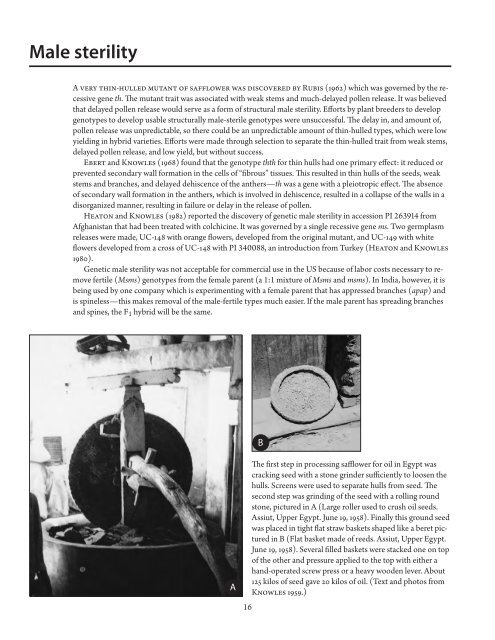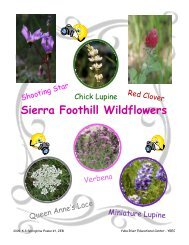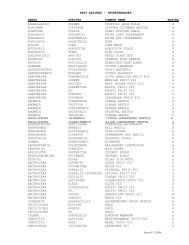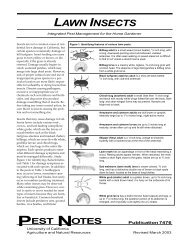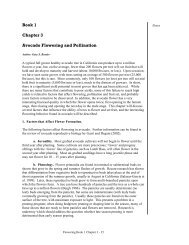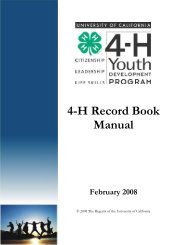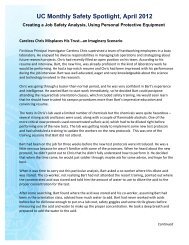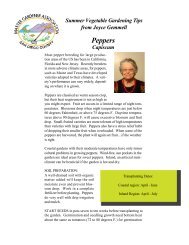Safflower in California - University of California Cooperative Extension
Safflower in California - University of California Cooperative Extension
Safflower in California - University of California Cooperative Extension
You also want an ePaper? Increase the reach of your titles
YUMPU automatically turns print PDFs into web optimized ePapers that Google loves.
Male sterility<br />
A very th<strong>in</strong>-hulled mutant <strong>of</strong> safflower was discovered by Rubis (1962) which was governed by the recessive<br />
gene th. The mutant trait was associated with weak stems and much-delayed pollen release. It was believed<br />
that delayed pollen release would serve as a form <strong>of</strong> structural male sterility. Efforts by plant breeders to develop<br />
genotypes to develop usable structurally male-sterile genotypes were unsuccessful. The delay <strong>in</strong>, and amount <strong>of</strong>,<br />
pollen release was unpredictable, so there could be an unpredictable amount <strong>of</strong> th<strong>in</strong>-hulled types, which were low<br />
yield<strong>in</strong>g <strong>in</strong> hybrid varieties. Efforts were made through selection to separate the th<strong>in</strong>-hulled trait from weak stems,<br />
delayed pollen release, and low yield, but without success.<br />
Ebert and Knowles (1968) found that the genotype thth for th<strong>in</strong> hulls had one primary effect: it reduced or<br />
prevented secondary wall formation <strong>in</strong> the cells <strong>of</strong> “fibrous” tissues. This resulted <strong>in</strong> th<strong>in</strong> hulls <strong>of</strong> the seeds, weak<br />
stems and branches, and delayed dehiscence <strong>of</strong> the anthers—th was a gene with a pleiotropic effect. The absence<br />
<strong>of</strong> secondary wall formation <strong>in</strong> the anthers, which is <strong>in</strong>volved <strong>in</strong> dehiscence, resulted <strong>in</strong> a collapse <strong>of</strong> the walls <strong>in</strong> a<br />
disorganized manner, result<strong>in</strong>g <strong>in</strong> failure or delay <strong>in</strong> the release <strong>of</strong> pollen.<br />
Heaton and Knowles (1982) reported the discovery <strong>of</strong> genetic male sterility <strong>in</strong> accession PI 263914 from<br />
Afghanistan that had been treated with colchic<strong>in</strong>e. It was governed by a s<strong>in</strong>gle recessive gene ms. Two germplasm<br />
releases were made, UC-148 with orange flowers, developed from the orig<strong>in</strong>al mutant, and UC-149 with white<br />
flowers developed from a cross <strong>of</strong> UC-148 with PI 340088, an <strong>in</strong>troduction from Turkey (Heaton and Knowles<br />
1980).<br />
Genetic male sterility was not acceptable for commercial use <strong>in</strong> the US because <strong>of</strong> labor costs necessary to remove<br />
fertile (Msms) genotypes from the female parent (a 1:1 mixture <strong>of</strong> Msms and msms). In India, however, it is<br />
be<strong>in</strong>g used by one company which is experiment<strong>in</strong>g with a female parent that has appressed branches (apap) and<br />
is sp<strong>in</strong>eless—this makes removal <strong>of</strong> the male-fertile types much easier. If the male parent has spread<strong>in</strong>g branches<br />
and sp<strong>in</strong>es, the F1 hybrid will be the same.<br />
A<br />
16<br />
B<br />
The first step <strong>in</strong> process<strong>in</strong>g safflower for oil <strong>in</strong> Egypt was<br />
crack<strong>in</strong>g seed with a stone gr<strong>in</strong>der sufficiently to loosen the<br />
hulls. Screens were used to separate hulls from seed. The<br />
second step was gr<strong>in</strong>d<strong>in</strong>g <strong>of</strong> the seed with a roll<strong>in</strong>g round<br />
stone, pictured <strong>in</strong> A (Large roller used to crush oil seeds.<br />
Assiut, Upper Egypt. June 19, 1958). F<strong>in</strong>ally this ground seed<br />
was placed <strong>in</strong> tight flat straw baskets shaped like a beret pictured<br />
<strong>in</strong> B (Flat basket made <strong>of</strong> reeds. Assiut, Upper Egypt.<br />
June 19, 1958). Several filled baskets were stacked one on top<br />
<strong>of</strong> the other and pressure applied to the top with either a<br />
hand-operated screw press or a heavy wooden lever. About<br />
125 kilos <strong>of</strong> seed gave 20 kilos <strong>of</strong> oil. (Text and photos from<br />
Knowles 1959.)


